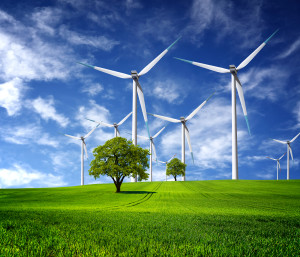 Harnessing the wind to produce energy is not a new concept. For hundreds of years, windmills have been used for grinding grain and pumping water. Today’s industrial windmill is called a wind turbine and is used to generate electricity.
Harnessing the wind to produce energy is not a new concept. For hundreds of years, windmills have been used for grinding grain and pumping water. Today’s industrial windmill is called a wind turbine and is used to generate electricity.
The blades of the turbine sit on top of a tower so they may capture the most wind. These towers are often more than 100 feet above the ground and at this height can take advantage of less turbulent and faster winds. There are typically two or three blades mounted on a shaft and forming a rotor. These blades catch the wind, turning the rotor to create energy which is later converted t electricity.
There are many wind turbine facts available to help understand just how wind energy works. There are proponents and opponents of wind energy, but the reality is that this is a good, renewable energy source and it is growing in popularity.
Here are ten wind turbine facts that will demonstrate just why wind energy is gaining such popularity.
- The fastest growing source of electricity production in the world is wind energy.
- Wind made up more than 36 percent of all new electricity generating capacity introduced between 2008 and 2012.
- The largest renewable energy company in the United States relies on more than 10,000 net megawatts (MW) of wind annually. This wind is produced by more than 100 farms and produce more than 57 percent of the utilities entire energy production.
- There is also a great deal of wind blowing offshore of the United States, creating more than 4,150,000 MW of wind each year.
- Even though they are growing in popularity, wind turbines are not without their problems. Opponents talk about operational problems. These include fires, explosions and even, collapses.
- The largest wind farm in the United States is located in Oregon. Shepherds Flat Wind Farm produces 846 MW, providing all of its electricity to Southern California Edison, Edison International’s utility company servicing southern California and providing electricity to more than 250,000 homes.
- There are major corporations investing in wind energy. These include Google, which owns a 37.5 percent stake in a wind farm off of the Atlantic shore and Wal-Mart, which uses electricity produced by Duke Energy’s wind turbines. Duke’s wind accounts for more than 1,000 MW of wind and more than 15 percent of the energy requirements for 350 Wal-Mart stores in Texas.
- Google also bought Makani Power, a start-up energy company. This company is perfecting the floating wind farm, a process capable of capturing high altitude winds. These winds churn out a great deal of energy, valued at more than $0.03 per kilowatt hour.
- With wind energy production continuing to grow, General Electric offers more than 11 different types of wind turbines. Energy companies may purchase these turbines which start at 1.5 MW and 120 foot blades to an offshore model that produces 4.1 MW and comes equipped with 185 foot blades.
- Wind power is expected to increase exponentially over the next few years. With the recent Congressional vote to extend the wind energy tax credit, wind is perfectly placed to become the next big renewable energy source.
These wind facts demonstrate that even though there is still much to be learned about harnessing the wind to produce electricity, it is clear that wind power is here to stay. Much will depend upon environmental regulations, available tax credits, technology advancements, and how competitive wind remains against other renewable energy sources.